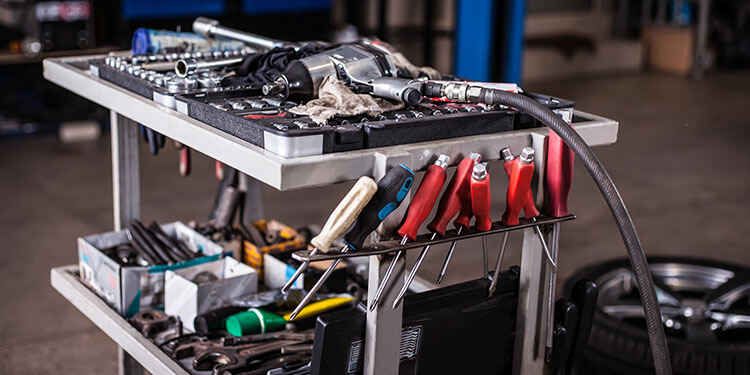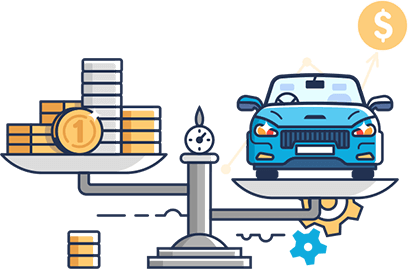If you’re past the point of maintenance and thinking about selling your car, just find out how much your car is worth now.
According to a recent Consumer Reports article, consumers are driving cars longer than ever these days. Specifically, the average age of vehicles on the road is 11 years – a three-year increase from what it was in 1995. While much of this can largely be credited to better vehicle technology, there’s also something to be said about consumers taking a greater sense of ownership in their automobiles – and for good reason. For instance, it’s estimated that driving a car for 200,000 miles or more can yield a financial savings of more than $30,000 for the average driver.
But getting your car to that 200,000 mile threshold is easier said than done. A good start is staying up to date with the basic maintenance that your vehicle needs to keep running great.
Here’s a look at our car maintenance checklist:
Oil Changes
The most convenient, affordable and basic of all vehicle maintenance is ensuring that your vehicle gets its oil changed every 3 months or 3,000 miles. Time between oil varies from car to car, so be sure to check your owner’s manual for proper oil life. If you’re handy, you can even do this yourself.
Think of oil as the lifeblood of your vehicle, as it keeps all the mechanical parts lubricated and working efficiently. However, oil gets dirty and grimy over time, which can increase friction and lead to premature wear. A conventional oil and filter change runs about $30 and can be professionally performed in minutes. It’s also worth noting that as you put more mileage on your car, you should opt for specialty high-mileage oil.
Check Your Fluid (Flush When Necessary)
Your vehicle needs a bevy of different types of fluids to perform up to its potential. There’s brake fluid, transmission fluid, power steering fluid, coolants and more. All of these fluids carry out an important task. You can check these fluids by simply popping the hood of your car and topping them off if and when necessary. If you take your vehicle into the dealer or auto shop for an oil change, the mechanics will usually perform this for you. Also, it’s important to flush certain fluids on occasion to keep certain systems running well. For instance, transmission fluid should be flushed every 50,000 to 100,000 miles and coolant should be flushed about every 40,000 miles, on average.
Check Your Tires
Tires aren’t just crucial to offering a smooth ride and ensuring your vehicle stops safely. No, under- or over-inflated tires and tires with uneven tread wear can wreak havoc on your vehicle (not to mention serve as a potential safety issue). For instance, under-inflated tires put more stress on the engine. Both under- and over-inflation, however, leads to premature tire wear – and new tires are no drop in the bucket from a cost perspective.
We recommend checking your tire pressure at least a few times a month – especially during the winter, when pressure has the potential to drop 1 psi for every 10-degree drop in temperature. It’s also important to have your tires rotated to ensure even tread wear every 6,000 miles (or about every other oil change). Finally, tires don’t last forever and should be swapped out for new ones when they’ve reached the end of their life. For the average driver, tires usually last about four years.
Spark Plugs
Most vehicles these days don’t recommend new spark plugs until you hit the 100,000 mile threshold, but it’s a preventative maintenance tip worth noting because healthy spark plugs are key to preventing engine breakdowns. Spark plugs are fairly easy to change yourself on most vehicles, are inexpensive and can help keep your engine working effectively and efficiently.
Fuel Injector Cleaning
You likely will only need to perform this task every 60,000 miles or so, but doing so helps remove deposits from the fuel system, as well as clean and clear intake valves and cylinder heads. There are many benefits to this type of service, notably a healthier, longer lasting engine and a marginal increase in fuel economy.
Our expert evaluators can help you get an accurate estimate for your cars value, FAST!

Other Items on a Car Maintenance Checklist
There are various other basic things you should be doing to keep your car in shape – and while these might not necessarily impact its drivability, they can impact its appearance and the driver experience. You can’t underestimate these factors when it comes to vehicle longevity, as it’s only natural for people to want to drive a car that looks good and is comfortable. On this note, here are some things to be aware of:
-
Windshield wiper replacement: If your windshield is streaky in the rain, it’s time to replace your wipers. These are affordable to purchase and an easy maintenance task to perform yourself.
-
Replace filters: Your cabin filter and engine filter require regular replacement. While your engine filter replacement is often lumped in with oil change service, the cabin filter is usually not, though mechanics will try to up-sell you on it. This is easy to do yourself and new cabin filters can be purchased just about anywhere. New cabin filters help make the drive more comfortable.
-
Wash it: To keep your car looking great, you need to keep its finish and paint job looking good. Regularly washing your car helps accomplish this by removing debris (bird droppings, dirt, grime, grease, etc.) and minimizing rust. Waxing your car a few times a year will also remove impurities that become embedded in the paint, keeping it shiny.
Regular Car Check-Ups
To a certain extent, this is something that you can largely do yourself. All it takes is popping the hood to check your fluid levels, checking underneath your car to make sure nothing is dripping or leaking and knowing how to check tire tread, brake pad and rotor wear.
However, if you want a more thorough, professional inspection, most auto shops offer such services as add-ons when you bring your vehicle in for an oil change. Every mechanic offers a different type of tune-up or inspection, so make sure you know what to expect before asking for the service to be performed.
As we noted in the opening, it’s important to think of your car as an investment. And like any investment, the more you put into it, the more you’ll get out of it. Be sure to go over the owner’s manual for manufacturer-recommended servicing and stick to a basic maintenance schedule. If you do, you’re much more likely to hit that 200,000-mile milestone, putting more money back in your pocket in the long-term. And if you do that, your vehicle will turn out to have been one great investment.
Eventually your car will hit the end of its useful life or be damaged to the point that maintenance become irrelevant. In that case, you can sell your car to CarBrain. Just click the button below to get a guaranteed, no-obligation offer for your car.




